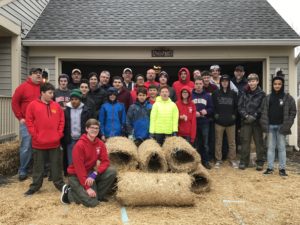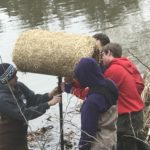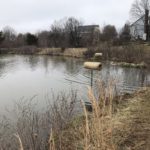 Mallard ducks and other waterfowl lay their nests on the ground near the edge of water, making them very vulnerable to predators like fox or raccoons. Some estimate nesting success as low as 10 percent for ground nests. Eagle Scout candidate Tapp Rhoads wanted to increase those odds, so he and his fellow Scouts from Ashburn’s Troop 997 spent a weekend building and installing mallard duck nesting tubes all around the Ashburn Farm area, helping protect eggs and ducklings until they’re able to fend for themselves. Nesting tubes of the design Tapp and his Troop have built are generally thought to increase nesting success by up to 80%. The tubes can be repaired and refurbished every year, making the project both near-term impactful and long-term sustainable.
Mallard ducks and other waterfowl lay their nests on the ground near the edge of water, making them very vulnerable to predators like fox or raccoons. Some estimate nesting success as low as 10 percent for ground nests. Eagle Scout candidate Tapp Rhoads wanted to increase those odds, so he and his fellow Scouts from Ashburn’s Troop 997 spent a weekend building and installing mallard duck nesting tubes all around the Ashburn Farm area, helping protect eggs and ducklings until they’re able to fend for themselves. Nesting tubes of the design Tapp and his Troop have built are generally thought to increase nesting success by up to 80%. The tubes can be repaired and refurbished every year, making the project both near-term impactful and long-term sustainable.
 With over 70% of Troop 997’s Scouts participating in the project and an ongoing outreach and education program, the Troop may also be eligible for the prestigious Hornaday Unit Award, one of the most coveted of environmental and conservation awards of the Boy Scouts of America.
With over 70% of Troop 997’s Scouts participating in the project and an ongoing outreach and education program, the Troop may also be eligible for the prestigious Hornaday Unit Award, one of the most coveted of environmental and conservation awards of the Boy Scouts of America.
From Tapp Rhoads:
My Name is Tapp Rhoads. I am a Stone Bridge High School sophomore and Eagle Scout candidate leading Scouts BSA Troop 997 in a conservation effort benefiting the Ashburn Virginia area. A crew of over 30 Troop 997 Scouts and I recently participated in a project to build and place mallard nesting tubes throughout the Ashburn Farm community.
The Hornaday medals are named to honor William T. Hornaday, noted conservationist who founded the National Zoo in Washington DC, and whose wildlife efforts are widely viewed to have helped saved the American Bison from extinction. Hornaday medals are given only to individuals who perform projects of significance in the areas of conservation and environmental awareness. The Hornaday Unit Award can only be earned by a Scouts BSA Troop when a high proportion of the Troop’s Scouts participate in an environmental project of substance that sustainably addresses an environmental or conservation issue, including educational elements for both the Scouts and the public at large.
After Troop youth leaders reviewed the legacy of William T. Hornaday and his awards at a recent Troop meeting, I outlined the project, including reviewing the conservation problems being addressed, the design and construction plans for the nesting tubes, and the planned installation locations. Mallard ducks and other waterfowl generally lay their eggs on the ground near water, making the eggs and later the hatchlings susceptible to predators. Nesting tubes provide a safe shelter to protect the young ducklings until they can fend for themselves.
I have worked closely with Chip Matthews of the Ashburn Farm HOA on the design of the mallard nesting tubes and mapping out the placement locations. While the initial project was completed in early March, I plan on leading annual maintenance and repair efforts, providing Troop 997 with conservation service opportunities for years to come.
Terry Kolb, Scouts BSA Troop 997’s Scout Master, and Paul Lynch, the Troop’s Senior Patrol Leader, are working with me to integrate the Hornaday Unit Award requirements with his Eagle project.
“We are excited about helping Tapp see his Eagle project to its conclusion, and about his willingness to combine his efforts with the attempt by our Troop to earn the Hornaday Unit Award,” said Scout Master Kolb.
“This has been a rare undertaking, and I’m proud of the massive support we’ve seen by Troop 997 Scouts,” added SPL Paul Lynch.
Scouts BSA Troop 997 is chartered by St. Theresa’s Catholic Church in Ashburn, Virginia, and meets there on Thursday nights at 7 PM. For more information, please contact Scout Master Terry Kolb at tkolb118@gmail.com.
This story has been updated from its original post with the addition of Tap Rhoads’ personal account.

